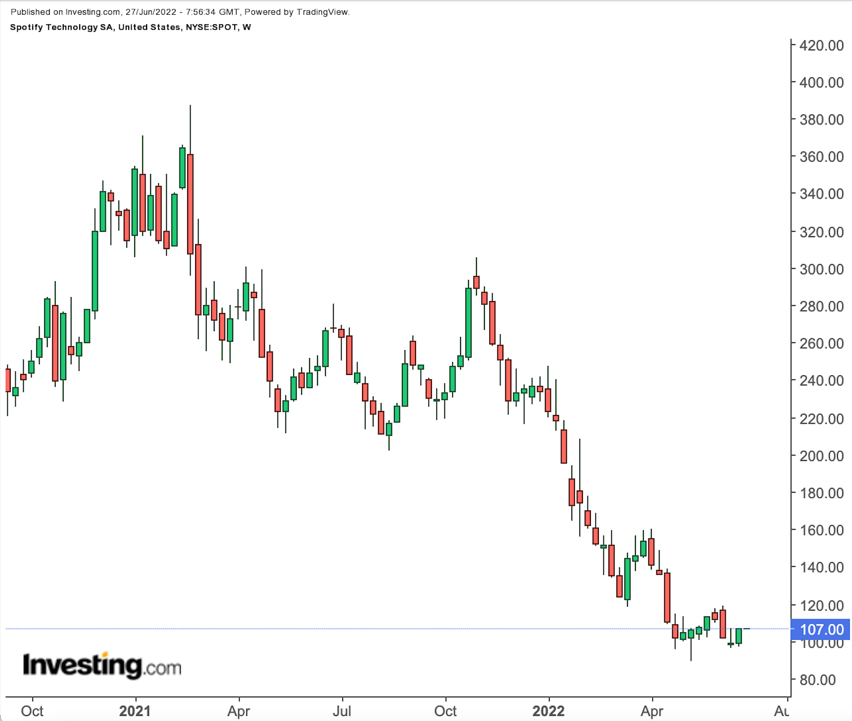China says Nvidia broke competition rules, extends probe; stock off lows
This article was written exclusively for Investing.com
It's exceptionally easy to make the bear case for Spotify (NYSE:SPOT) stock. Even with the shares off 54% year-to-date and 65% from their 2021 high, Spotify still has a market capitalization just shy of $20 billion.
That's a dramatically high valuation for a company that essentially is making zero profit. (Operating income over the past four quarters is 74 million euros (approximately $78 million.) And while Spotify is growing revenue at a rapid clip, the nature of the business suggests that revenue growth isn't necessarily going to drive significant expansion in profit margins. Indeed, that's been precisely Spotify's history to this point.
But looking closer, there's actually a quite intriguing case for Spotify, one highlighted by this month's Investor Day. Management's grand plan for the next decade isn't likely to play out perfectly, but if it does, the potential upside is enormous. Even if grandiose targets aren't hit, success outside of the core business does suggest continued revenue growth and precisely the profitability for which investors have been waiting.
To be sure, this might not be the right time to own a stock with a speculative long-term case. The core reason that Spotify stock has sold off sharply since the beginning of November is that investors are no longer so willing to wait years for profits to arrive. At some point, however, that will change—and when it does, SPOT stock could be headed for a rebound.
The Case Against Spotify Stock
There are two core risks with Spotify. The first, as noted, is the valuation. It's worth remembering in this market that the size of a stock's decline doesn't, on its own, create an attractive valuation. So many stocks last year in retrospect look to have been dramatically overvalued; Spotify's peak market cap above $50 billion was more than 500x operating profit. There's no reason SPOT has to or even will, return to that kind of multiple or that valuation.
SPOT bulls might point out that, relative to revenue, the stock does look much more reasonably valued: it now trades at a less than 2x multiple. But that multiple is a direct reflection of the second risk: that Spotify's gross margins are low, and may well stay low.
In 2021, Spotify's gross margins were just 26.8%; the figure dipped to 25.2% in Q1 2022, down from 25.5% the year before. And so, the comparison to software stocks, most notably, that are often valued on revenue doesn't work. Spotify's gross margins in fact are much more like those of online pet retailer Chewy (NYSE:CHWY) than a 'true' tech company.
Bears would argue that those margins aren't going to move much. The problem is that Spotify has to pay music labels for its product. Those labels have a good deal of negotiating power.
Because of those low gross margins, Spotify can't and won't perform like a typical platform business. Those businesses have exceptionally high incremental margins, which leads to explosive improvements in profitability as revenue grows.
When Meta Platforms (NASDAQ:META) added a new user, its extra costs were minimal, making that user exceptionally profitable. The same is true for companies like Match.com (NASDAQ:MTCH), eBay (NASDAQ:EBAY), or Etsy (NASDAQ:ETSY).
But because of royalty expenses, an incremental Spotify user is not much more profitable than an existing one. And so even as revenue grows, profit margins stay stuck.
Again, that's precisely what has happened so far. In 2018, Spotify generated revenue of 5.3 billion euros, gross margins of 25.7%, and an operating loss of 43 million euros. Last year, revenue was 84% higher, yet gross margins were only about 100 basis points better.
Over the three years, revenue increased by 4.4 billion euros; operating income rose just 137 million euros, implying incremental operating profit margins of a paltry 3%.
The problem is that with a $20 billion market cap, Spotify needs to add a couple of billion euros worth of operating profit to move the stock higher over a multi-year period. With those kind of incremental margins, even substantial revenue growth isn't getting the business to that point. Instead, in that scenario, Spotify does little more than simply run in place.
Management Makes The Case
This bear case is well-known. So well-known, in fact, that Spotify chief executive officer Daniel Ek addressed it during his prepared remarks at Spotify's Investor Day earlier this month.
Ek noted, “two potential explanations” for the lack of gross margin expansion. The first, he admitted, was that “Spotify simply isn't that good [of] a business.”
Of course, that's not the explanation Ek believes is correct. Rather, Spotify is investing in its business. The biggest way it's done so is through its foray into podcasting, notably with a deal with Joe Rogan worth a reported $200 million.
Right now, however, those podcasts aren't profitable. And so, they are hiding some of the improvement in the music business. Ek said at the Investor Day that gross margin was about 28.5%, on the way to a previously expressed target of 30-35%.
Over time, as Spotify better monetizes its podcast inventory, gross margins in that business should be better than music: Ek estimated a level between 40% and 50%. The still-small marketplace business should be even better.
Essentially, the argument from Ek is that Spotify could have posted the margin expansion investors are looking for; it chose not. Instead, it spent up (through both acquisitions and ongoing expense) to build out a podcast business, as part of a plan to be a “destination for creators,” not just musicians. That plan includes audiobooks as well, and more initiatives could follow.
By delaying profitability, Spotify is increasing what that profitability could be.
Targets Suggest Huge Upside
Ek's argument makes seems credible. His financial targets, however, are perhaps harder to swallow.
Ek said at Investor Day that Spotify in a decade could generate $100 billion in revenue—more than 10x the 2021 figure—at 40% gross margins and 20% operating margins.
Ek admitted the targets were “audacious.” A Wall Street analyst used a different phrase: “thinly supported.” Notably, Spotify expects its revenue per user to roughly quadruple, a massive step-up in spending that seems difficult to achieve in ten years, if at all.
If they're achieved, there is room for enormous upside in SPOT stock. $20 billion in operating profit would suggest about $15 billion in net income (the statutory tax rate is 25%, according to Spotify filings). A 20x multiple to that figure would value Spotify at $300 billion, 15x above the current level, and there's no reason the dominant business in the creative arts would only trade at 20x.
Now, the question becomes: is Ek right? Truthfully, it's hard to see Spotify hitting precisely these targets. Whether in terms of per-user revenue, the contribution of podcasts, or competition from giants like Amazon (NASDAQ:AMZN) and Apple (NASDAQ:AAPL), there is no shortage of potential stumbling blocks.
That said, investors should consider the qualitative argument Ek is making, even if they don't necessarily trust the quantitative forecast. There is a good business in here somewhere, and a business that should over time generate some level of profitability. How much and how soon are the key questions.
Disclaimer: As of this writing, Vince Martin has no positions in any securities mentioned.
***
Looking to get up to speed on your next idea? With InvestingPro+, you can find:
- Any company’s financials for the last 10 years
- Financial health scores for profitability, growth, and more
- A fair value calculated from dozens of financial models
- Quick comparison to the company’s peers
- Fundamental and performance charts
And a lot more. Get all the key data fast, so you can make an informed decision, with InvestingPro+. Learn More »
